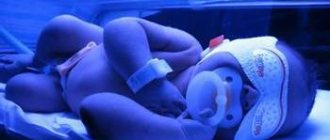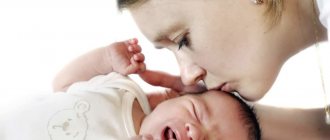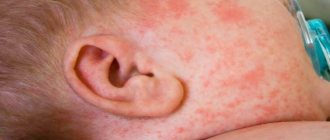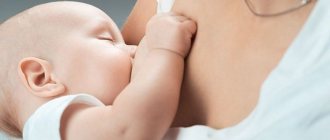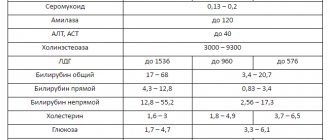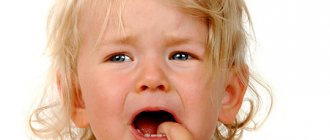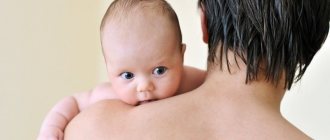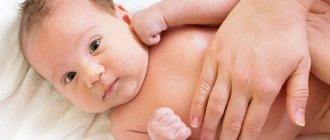Reasons, features, dangers
Acne in newborns usually occurs immediately after birth. It appears on the skin in the form of small red pimples with a yellowish or whitish hump of pus inside, like regular acne due to hormonal changes in adolescents.
In most cases, the rash appears 15 to 20 days after birth. Acne can cover a baby's entire face, but some babies have isolated pimples. The pathology is diagnosed in approximately one third of newborns.
If the rash is not caused by diseases of the internal organs and does not require therapy, then after 2–3 weeks it goes away on its own.
The main reason for the appearance of rashes is a hormonal crisis. Newborns have high levels of maternal sex hormones in their bodies. In addition, the child’s endocrine system is not yet fully formed and cannot cope with its functions.
Hormonal crisis in children is diagnosed in the first days of life.
In addition to acne, infants may exhibit signs of puberty characteristic of adolescence:
- swelling of the genitals;
- mastopathy of physiological nature;
- metrorrhagia and hydrocele of the testicles.
The appearance of these signs is explained by the presence in the child’s body of a significant amount of the hormone estradiol, which was supplied to the baby from the mother in the last months of intrauterine development. It causes a rash to appear on the face. Hormone therapy may be prescribed to balance his hormonal levels.
Newborn acne (photos of the face and neck show the main places where the rash appears) can appear for the following reasons:
- Genetic predisposition (if a woman suffered from skin rashes before pregnancy, the baby will be at risk).
- High levels of lipophilic yeast in the child’s body, which contributes to the development of inflammation.
- Undeveloped sebaceous glands . If the glands cannot cope with an excess of fatty tissue, then they gradually become clogged.
Acne of newborns, the photo of which is presented in this article, can also appear on other organs, including the genitals. In boys, acne on the penis may be accompanied by testicular hydrocele. In girls, the process can be complicated by engorgement of the mammary glands.
If the physiological rash proceeds without complications, then after a few weeks there will be no trace of pimples left. But if an infection gets into the baby’s skin, then the inflammatory process begins. The rashes degenerate into pustules, in which pus forms. Young children have a very difficult time with the inflammatory process.
They may develop severe consequences of acne:
- furunculosis is a disease of a purulent-necrotic nature;
- streptococcal impetigo is a pathology based on streptococcal infection;
- streptoderma is an inflammation of the skin caused by streptococcal bacillus.
Therefore, when the first signs of a rash are detected in a baby, it is better for parents to show it to the pediatrician. A specialist will examine the baby’s skin and give the necessary recommendations.
Why does acne appear in newborns?
In pediatrics, this disease is called neonatal cephalic pustulosis. The main places of localization are forehead, cheeks, chin. The rash also appears on the head, in the place where the hair grows. With acne, other parts of the body are not affected, which makes it easier to recognize the nature of the disease.
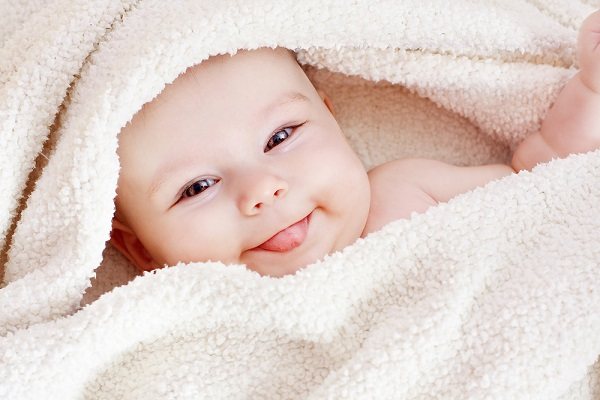
According to Dr. Komarovsky, the causes of acne on the face of a newborn lie in physiology and do not require special treatment. He states that this is a normal process for children under 1 year of age and explains the rash as follows:
- The hormone estrogen, which is actively produced by the mother’s body, stimulates the accumulation of subcutaneous fat in the baby and provokes the appearance of acne;
- Activation of sex hormones in combination with poorly functioning sebaceous glands causes skin formations, as an increased amount of sebum is produced.
Other pediatricians also explain the development of acne as a natural adaptation of the baby’s skin to an aggressive environment. According to statistics, 20% of infants experience acne, which many pediatric specialists do not even consider to be a pathology. In scientific research you can find the wording “functional state”. According to doctors, it is caused by the baby’s adaptation to the world around him.
Classification of acne in newborns
There are several types of rashes on a child's skin.
The following types of acne are distinguished::
- Milium. These are small whiteheads localized on the child's nose. As a rule, milia is diagnosed in infants in the first days of life. The rash does not cause problems and goes away within 15–20 days. There is no therapy.
- Toxic erythema. It is a yellowish or whitish rash surrounded by a red ring. Erythema, as a rule, appears on the baby's abdomen in the first days of his life. Acne also goes away without treatment.
- Prickly heat. The rashes are red pimples that are localized on wet areas of the baby’s body: behind the ears, in the groin, in the folds of the neck. In severe cases, the rash becomes purulent. Miliaria needs to be treated: apply tampons soaked in cool water or a soda solution to the affected areas of the skin (dissolve a teaspoon of baking soda in 250 ml of water). In addition, pediatricians recommend leaving infants without diapers as often as possible.
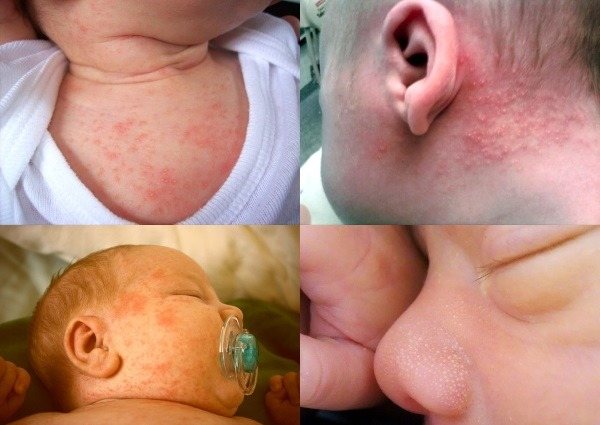
- Seborrheic dermatitis. The rash resembles small nodules and crusts that appear in the area of the baby's face and neck. Dermatitis is caused by subcutaneous sebum that clogs the glands.
- Allergic rash. Red itchy spots on the face and body of a newborn are caused by improper nutrition of the mother (or an incorrectly selected formula for the baby). Allergies can also be triggered by external irritants or diseases of internal organs. It is recommended to treat an allergic rash only under the strict supervision of a doctor; self-medication is dangerous.
Causes of acne in newborns
The question of the causes of the problem is no less important than how to distinguish newborn acne from allergies, studying photos of rashes. The main causes of acne are presented below:
- a large amount of hormones in the blood of a newborn, transmitted from the mother in the third trimester of pregnancy;
- imperfect functioning of the baby’s sebaceous glands in the first weeks after birth;
- penetration of hormones into the baby’s body along with mother’s milk during feeding. your baby's metabolism .
- acne or allergies in newborns may be a consequence of the child’s delicate skin adapting to a “non-sterile” world.
How it begins. First signs of what it looks like
Acne of newborns (photos on the face, head, in rare cases - in the neck and back, showing the localization of red pimples) has the following first signs:
- white-red acne areas appear in the area of the nose and cheeks, the rash may have a pearlescent tint;
- Small white pimples may be seen in the center of larger pimples;
- the rashes do not itch or cause concern;
- despite acne, the child is active, eats and sleeps normally;
- in infants, unlike adolescents, comedones are practically absent.
Flowering of newborns: signs and causes, photos
Newborn blooms usually appear between 2 and 4 weeks of life. This is a normal physiological phenomenon, which indicates that the baby’s skin is cleansing and adapting to the external environment.
The human body. Medical Eniclopedia: - M., 2011
We will tell you in more detail what the signs are, the reasons, and what to do when such a rash appears. Here are the external signs that indicate skin bloom:
- yellowish, whitish or bright pink areas will appear on the baby’s head, neck, chest and back;
- White pimples appear on the cheeks and head;
- the affected areas do not itch, the child feels discomfort only when touching the affected areas with a damp towel or napkin;
- A crust forms on reddened or whitened areas.
Depending on the cause, this rash can last from a week to several months.
Main symptoms
There are other symptoms of acne in children. The skin around the rash becomes red, pink or whitish. Many children have oily facial skin.
Skin rashes
On the skin of infants, rashes are manifested by the following symptoms:
- The rash covers only the child's face; isolated pimples can be seen on the head.
- Reddish spots may change color to whitish, pink or yellow.
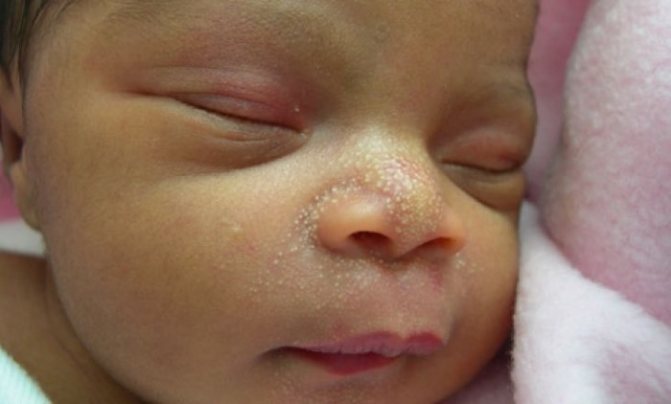
Acne on the face and body in newborns is a disease that resembles allergies, but is caused by other reasons.
- Acne may also appear on the baby's body, especially on the stomach and back. But the acne is much smaller than on the cheeks and nose.
- Pimples are not accompanied by other uncomfortable sensations, so the child behaves actively.
- In places where the skin is damaged, a fatty film forms, since the sebaceous glands work very actively.
Swelling of the genital organs
In boys, the testicles may swell, but the process does not cause discomfort and goes away over time without therapy. The main thing is to adhere to the rules of child hygiene.
Some little girls may experience bloody vaginal discharge in the first days of life. There is no need to be afraid - this is a physiological hormonal process. After a few weeks, the discharge will stop. You just need to wash your newborn more often than usual.
In addition, some girls after birth experience a whitish coating between the folds of the labia. This plaque must be removed very carefully, and after complete removal, lubricate the genitals with baby oil.
Breast enlargement
Since skin rashes in infants are associated with a sexual crisis, most children of both sexes may experience swelling of the mammary glands. This physiological feature lasts from 10 days to a month of life. There is no need to treat the child, just carefully monitor his hygiene.
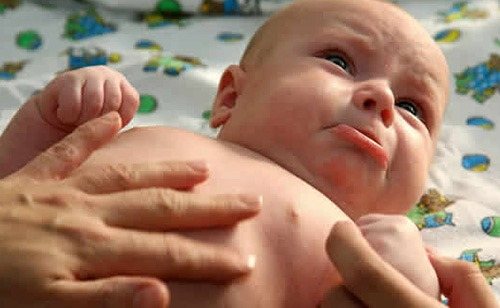
Some children produce fluid from the mammary glands that resembles colostrum. It is impossible to squeeze out the liquid, since you can break the protective film that protects the child’s glands from infection.
How to distinguish from allergies and prickly heat
Acne in newborns differs from prickly heat and allergic manifestations in the type and location of acne, as well as the health status of the newborn. With acne, pimples are localized on the face, while with other types of rashes they are located throughout the body.
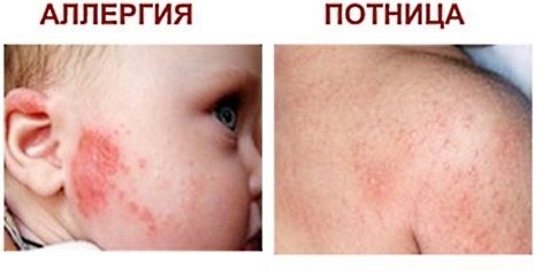
You can compare photos of these 3 types of rashes and see some distinctive features. To make it clearer, the distinctive features can be summarized in a table.
| Name of rash | Appearance of rashes | Localization of acne | Child's well-being |
| acne | there are blisters with purulent contents | in the area of the nose and cheeks, rarely on the head and body | The child is active, sleeps and eats well |
| allergy | the rash is varied, but without blisters with purulent contents | all over the body | the child is restless because the allergy causes severe itching; other symptoms possible |
| prickly heat | small red rash | all over the body except the face | slight anxiety, itching; the child’s well-being does not change. |
But if there is any doubt about the diagnosis, it is better to show the baby to a pediatrician. An experienced doctor will make a diagnosis and, if necessary, select treatment.
Differences between acne and allergies
Acne in newborns may at first glance appear similar to an allergic rash.
Having noticed a rash on your baby’s face, it is recommended to make sure that it is acne and that it will go away on its own. At first glance, acne in newborns may seem similar to an allergic rash, which also often appears in babies aged 1-6 months. Qualified doctor. Of course, he will immediately make an accurate diagnosis, but you can determine the nature of the baby’s pimples yourself. There are several main differences that make it possible to determine whether it is acne or allergies in a newborn child:
- A simple baby rash looks like pimples that are red below and white and purulent above. With allergies, the pimples also have a red tint, but there are no white purulent tops;
- The location of acne varies. In both cases, the rash is on the face, but with flowering it is in the center of the face, then with allergies it is on the cheeks or other parts of the body;
- in case of an allergic reaction, the rash itches and brings discomfort to the baby, which is not observed with acne;
- in the presence of ordinary acne, the child sleeps well and has an excellent appetite, and in case of allergies, the child eats and sleeps poorly;
- With allergies, infants may also experience severe redness of the cheeks, changes in stool, the appearance of rough spots throughout the body, and abdominal pain.
Acne goes away as quickly as it appears and does not require complex treatment. But allergies are already a serious disease that needs immediate treatment, otherwise it can develop into a chronic form and cause concern to the baby for many years. Therefore, you need to consult a doctor who will determine what it is: newborn acne or allergies?
Treatment
As a rule, there is no need to treat newborn bloom. The pediatrician prescribes medications and ointments only when the acne does not go away for 3–4 months, and the pathological process progresses. It is recommended to begin any therapy for rashes in infants only after the diagnosis has been confirmed by a pediatrician.
Even if a particular medicine helped one child get rid of acne, this does not mean that it will help another.
Acne ointments
The pediatrician most often prescribes the following ointments for the baby:
- ketoconazole 2%: it is recommended to smear the affected areas of the skin 2 times a day;
- hydrocortisone ointment 1%: apply to the rash once a day.
Diaper rash ointments containing zinc help dry out pimples. For example, "Bepanten". You can lubricate pimples with ointment no more than once every 2 to 3 days.
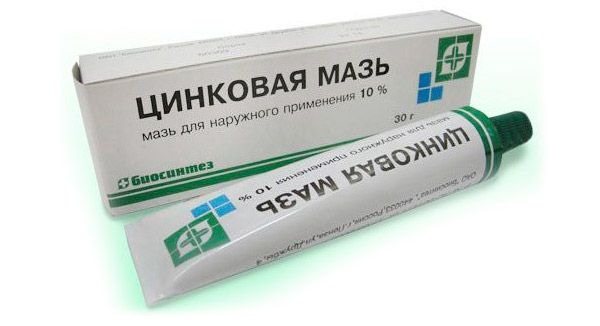
There is no need to wipe the rash with Chlorophyllipt and other antiseptic agents, since this procedure will not give the expected effect. It is better to very carefully wipe the baby’s delicate skin with swabs soaked in a decoction of chamomile or chamomile. Parents should monitor the condition of the baby's skin to ensure that it always remains dry and clean.
Traditional methods
Traditional methods of therapy can be used to treat rashes in infants. As a rule, to relieve the inflammatory process, decoctions of string, calendula, chamomile or other medicinal plants are used. It is recommended to wipe the baby's skin daily with tampons soaked in a lukewarm broth.
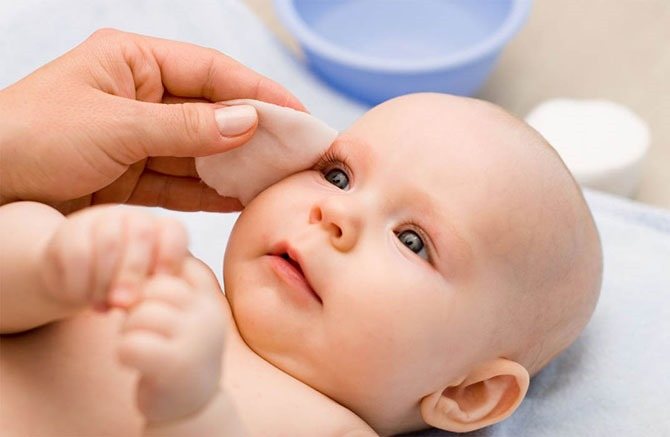
It is advisable to wipe the baby's face in the morning, when the baby has just woken up. Children sweat a lot during sleep, so the number of acne may increase in the morning.
But decoctions of medicinal herbs and plants must be used with special care, since the risk of allergies is high. Before treatment, be sure to consult your pediatrician.
Aloe juice can dry a child’s skin and relieve inflammation, since this healing plant is rich in vitamins and microelements. But children in their first year of life should not wipe their faces with this traditional medicine, as an unexpected allergic reaction may occur.
A nursing mother is allowed to take up to 10 g of aloe juice (freshly squeezed) daily, diluting it with lemon juice. There are certain subtleties in preparing aloe juice. It is necessary to use the lower leaves of a plant that is more than 3 years old.
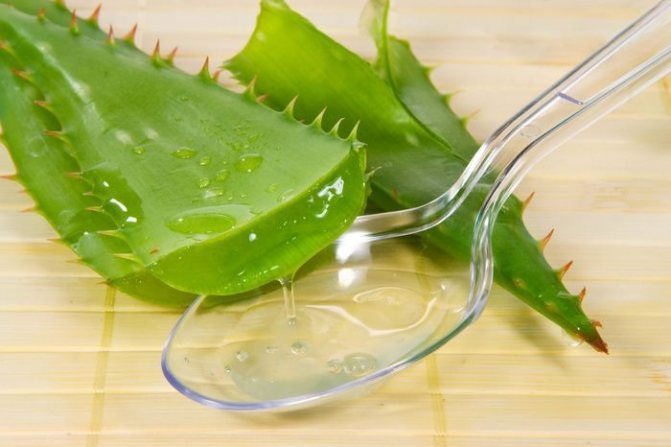
The healing effect of plucked leaves lasts no more than 4 hours, so the juice must be squeezed out immediately. The cut leaf should be thoroughly washed and peeled. The outer layer is carefully cut off and the juice is squeezed out of it.
Skin care and bathing
Pediatricians strongly advise bathing children in their first year of life in boiled, clean water. Taking baths with herbal decoctions is not recommended, as it can provoke allergies. But it is allowed to wipe the affected areas of the skin with a decoction of herbs.
This procedure:
- has a positive effect on the baby’s delicate skin;
- prevents the child from inhaling herbal vapor.
Safe herbs allowed from the first days of life are called calendula and string. But for the first time, only one of them should be used to make a decoction for wiping the face. If the child tolerated the procedure well, then you can use another herb. The rash areas should be wiped 2-3 times a day, do this very carefully, without squeezing the pimples.
Newborn acne, a photo of which many experienced parents have seen on the face, sometimes appears on the baby’s body. If this happens, then it is allowed to bathe the baby in a weak solution of manganese (the water should have a slightly pinkish tint).
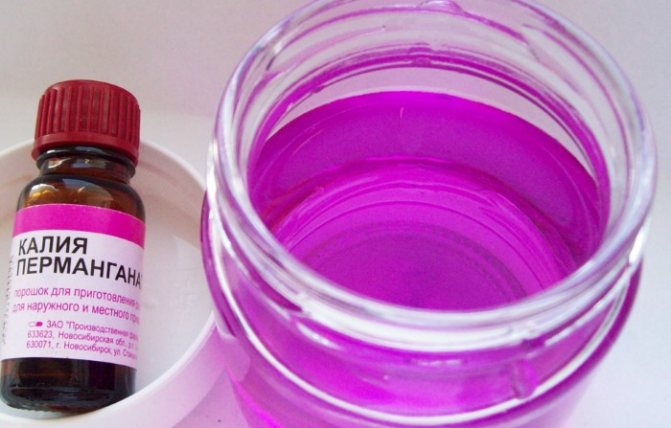
The procedure is carried out very carefully; water should not get into the eyes or mouth of the newborn.
Child nutrition. Juices
If a baby has pimples on his face, the nursing woman’s diet needs to be adjusted. It is necessary to include freshly squeezed fruit juices in the mother's diet.
Cocktails consisting of freshly squeezed juices are useful:
- pumpkin;
- carrot;
- apple
A nursing woman should drink 40 g of cocktail once a day, preferably doing this in the morning. A newborn may experience an allergic reaction, therefore, when starting treatment with juices, it is necessary to dilute the first portions of the cocktail with water in a 1:1 ratio.
Vitamin therapy
To restore the epidermis, a newborn's skin needs vitamins E and A. But giving fat-soluble vitamins to a small child is very dangerous, since their overdose in the body can cause unforeseen side effects.
Therefore, the baby should receive the daily dose of vitamins from mother’s milk. A woman who is breastfeeding needs to enrich her diet with foods rich in vitamins A and E. Only new foods should be introduced into the diet of a nursing mother gradually, otherwise the baby may experience an allergic reaction.
Advice from Dr. Komarovsky
The famous pediatrician Komarovsky does not recommend touching a physiological rash on the face of a small child, since after a few weeks the rash will go away without treatment.
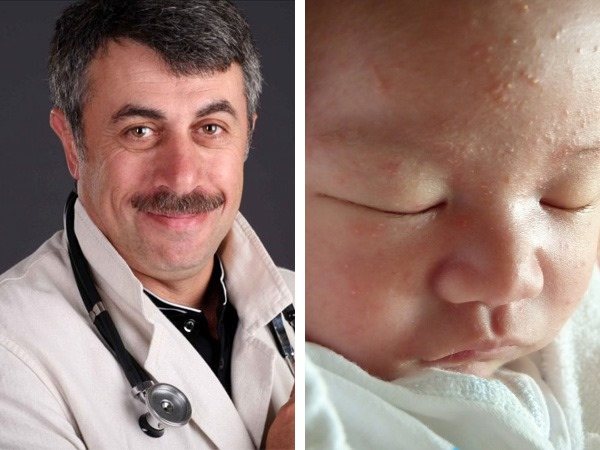
Treatment of acne in infants involves the use of Bepanten or an ointment containing zinc. But, according to Dr. Komarovsky, medications do not have a pronounced effect on children's skin, but only slightly dry out the acne.
How to treat acne in newborns
As a rule, treatment for acne in newborns is not required. They resort to medications if the baby’s acne does not go away over the course of a couple of months, but only progresses. Any treatment for acne in newborns begins with the recommendation of a pediatrician after the diagnosis is confirmed.
Even if a particular drug helped one child to cure acne, this does not mean that it will have the same effect on another. Each organism is individual, the drug helps some, but only aggravates the situation for others.
Often, the doctor recommends the following medications:
- 1% hydrocortisone cream, applied once a day;
- 2% ketoconazole cream, use 2 times a day.
Without exception, mothers and fathers cannot just watch if the child’s face is covered in acne. They try to process them with something, dry them, and in some cases even squeeze them out. The latter should not be done under any circumstances - this can cause the wounds to become infected, which will cause severe inflammation. It is also undesirable to apply fatty oils or creams to the baby's skin. They contain components with a high fat content, which leads to clogging of skin pores.
Dr. Komarovsky does not recommend touching the rashes; over time they will disappear on their own. Treatment of acne in newborns consists of using zinc ointment or Bepanten, but they do not show any significant effect, but only dry out acne on the skin of infants and slightly reduce inflammation.
What is prohibited for skin rashes
If a newborn is diagnosed with acne, then the following actions are strictly contraindicated:
- Apply lotions or baby oil to the affected areas. It is also prohibited to treat a child with ointments and creams that contain an antibiotic.
- Lubricate acne with antiseptic agents (Chlorophyllipt, brilliant green and analogues).
- Squeeze pimples as they can cause infection. An inflammatory process will begin, fraught with the appearance of scars and other complications.
- A nursing woman should worry because an emotional outburst provokes the production of the hormone cortisol in her body.
When to see a doctor
Newborn bloom can bother a baby from several weeks to several months. There is no need to treat the child.
You should consult a doctor in the following cases:
- the rash does not go away for more than 3 months;
- the rashes are rapidly increasing;
- a dry crust appeared on the face;
- an infectious process has become involved;
- the child is capricious and refuses food.
Acne in newborns, according to many pediatricians, is a natural physiological process of adaptation of the child’s body to life in the external environment, which does not require special treatment.
Provided the newborn's hygiene standards are observed in the first months of life, the rashes go away on their own. However, if you notice a severe rash on the face or body, as in the photos above, you should consult a pediatrician. In addition to caring for the baby’s skin, it is necessary to carefully monitor the nutrition of the nursing mother.
How to distinguish newborn acne from allergies?
An allergist-immunologist describes in great detail what an allergic rash looks like in young children and tells what medications the doctor can prescribe.
Useful and comprehensive information about what types of allergies there are in infants and how to prevent the occurrence of such conditions.
A clinical laboratory diagnostics doctor will talk about what methods and techniques exist for detecting allergies in young children.
Many parents often hesitate when examining a rash on their child's face. What is this? Newborn acne or allergies?
Baby acne and skin rashes are two common skin conditions, and both can appear when babies are between one and six months old.
- both phenomena usually affect the face. However, a child’s acne is most often located in his central part, and allergies appear on the cheeks and other parts of the body;
- acne and allergic rashes are red in color. But baby pimples are raised and don’t itch. Children's allergies manifest themselves in the form of swollen itchy spots;
- Infant acne usually goes away without special treatment. Allergies can accompany a child throughout his life. And always needs a special diet, skin care and drug treatment during an exacerbation.

